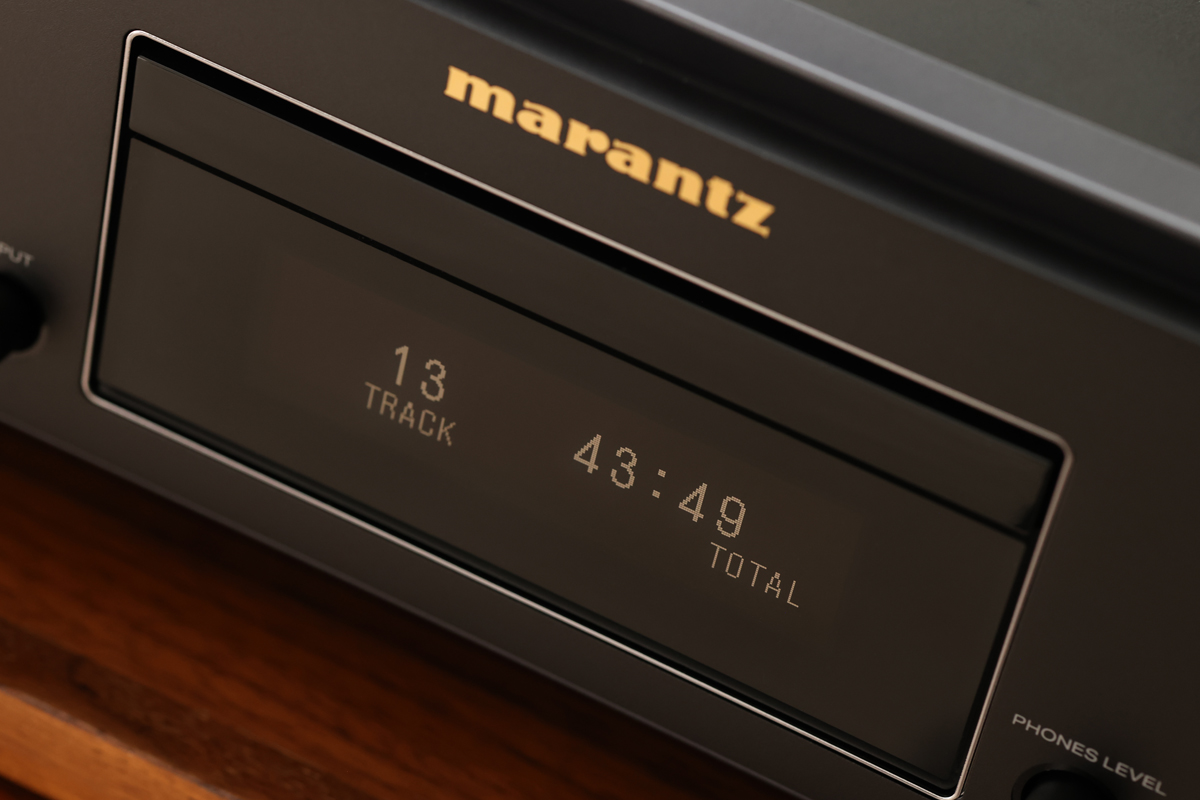Note: for the full suite of measurements from the SoundStage! Audio-Electronics Lab, click this link.
 I love it when a hi-fi manufacturer gets into a groove, and Marantz seems to be doing exactly that with its recent two-channel gear. For a while now, the upper end of the company’s two-channel range has been dominated by two-piece solutions, with an all-analog integrated amplifier handling preamplification, source-switching, volume control, and power duties, and a separate disc player/streamer/DAC doing everything else—well, everything except for vinyl and tape playback.
I love it when a hi-fi manufacturer gets into a groove, and Marantz seems to be doing exactly that with its recent two-channel gear. For a while now, the upper end of the company’s two-channel range has been dominated by two-piece solutions, with an all-analog integrated amplifier handling preamplification, source-switching, volume control, and power duties, and a separate disc player/streamer/DAC doing everything else—well, everything except for vinyl and tape playback.
We’ve seen this play out at the very tippy-top of the high end of Marantz’s lineup—namely with the SA-10 ($7499) and PM-10 ($8999)—as well as in the middle market with the SACD 30n and Model 30 ($2999 each, all prices USD). But the new CD 50n streaming CD player—and its companion piece, the Model 50 integrated amplifier—embody the concept at a price point ($1800 each) where Marantz normally takes a more all-in-one (or perhaps everything-but-discs-in-one) route.
Inside and out
Both pieces sport the new aesthetic that debuted with the Model 30 and SACD 30n and cut no corners in terms of aesthetic design and build quality as compared with their pricier siblings. So, what’s lost in the value engineering? Well, as the nomenclature implies, the newer, more affordable model lacks SACD playback capabilities. And it’s manufactured in Vietnam instead of Japan. But it adds an HDMI input, which is very welcome.
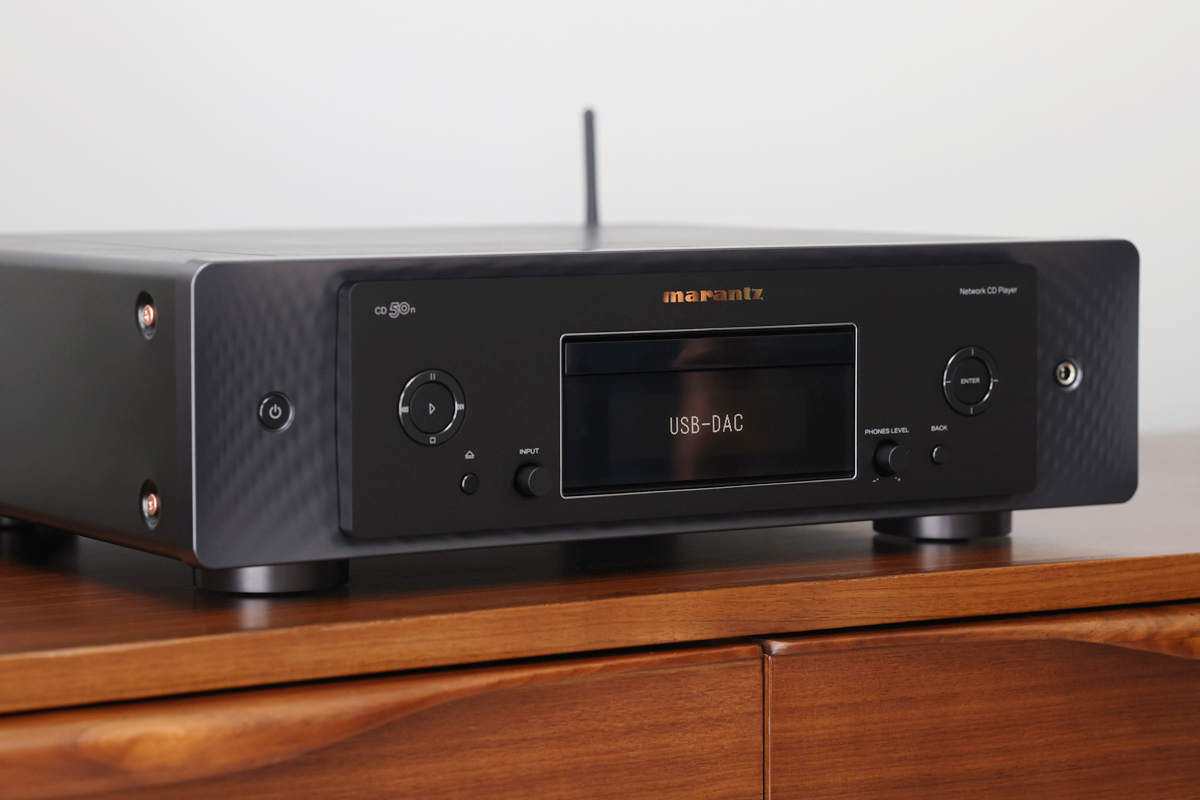
On its own terms, the CD 50n features optical (TosLink) and coaxial (RCA) S/PDIF inputs, along with a USB Type-B connection and the aforementioned HDMI ARC port. It also has optical and coaxial digital outputs, fixed and variable stereo RCA outs (because in addition to all of the above, this thing is also a preamp in its own right), a flasher in, RS-232 control connectivity, and parent-company Masimo Consumer’s own proprietary remote-control connection (RCA). In terms of networking and wireless connectivity, it has an ethernet port and Bluetooth/Wi-Fi antennas. There’s also a 5V/1A USB connection on the back panel.
File format support includes MP3, WMA, AAC, FLAC, ALAC, and WAV, and the DAC supports word lengths up to 24 bits and sample rates up to 384kHz for PCM, and DSD sample rates up to 11.2MHz (aka DSD256).
Setup and software
The real draw here—aside from CD playback, of course—is the CD 50n’s support for Masimo Consumer’s HEOS multiroom wireless streaming platform, which got a big update right around the release of the 50n. New features include a universal search function, a persistent Now Playing widget at the bottom of the app, and the ability to create mix-and-match playlists including songs from different streaming services. Sadly, Qobuz is still missing from the list of supported services.
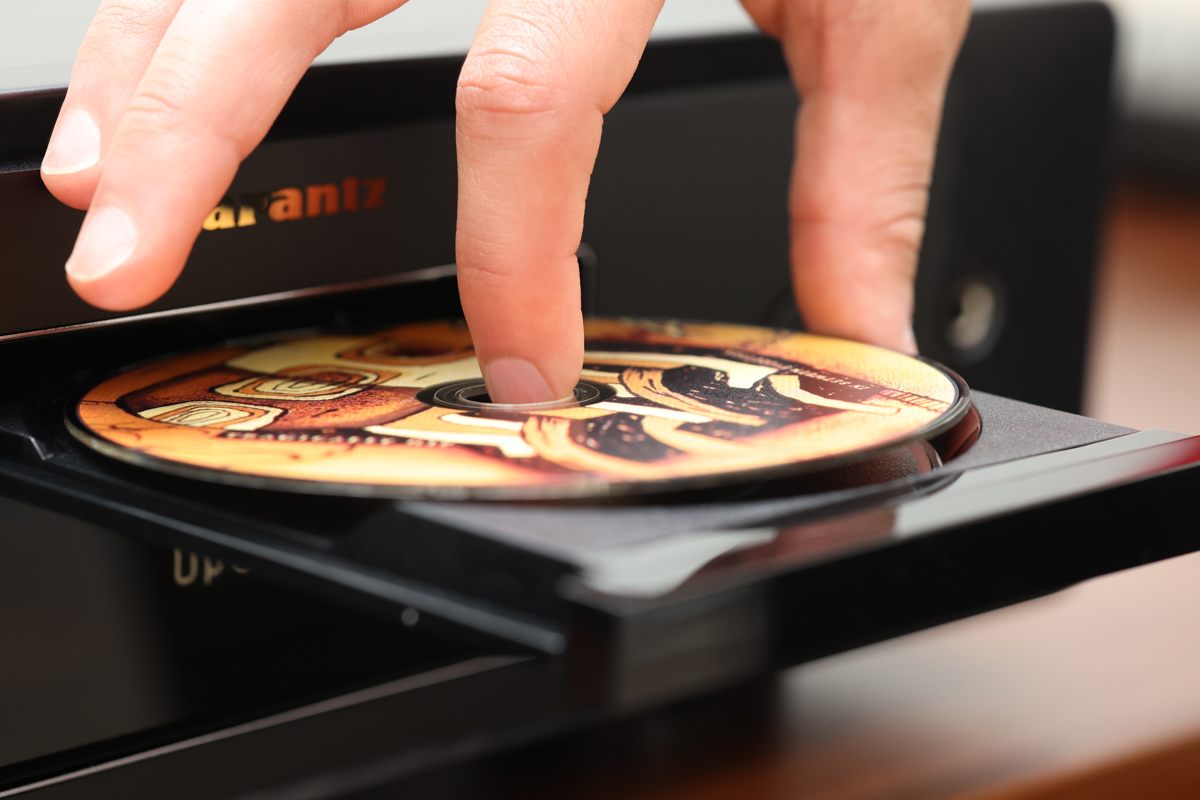
In terms of setup, the CD 50n is sort of as simple or as complicated as you want to make it. For network connectivity, if you plug in an ethernet cable and fire up the HEOS app, it just sorts itself out. For Wi-Fi, it’s only slightly more hands-on, but so uncomplicated that it would take me longer to describe than it did to do it. This thing is very nearly the embodiment of plug-and-play.
The only real quirk I came across in the setup process is that a handful of features can only be dialed in via the remote control and the front-panel readout. One—choosing between reconstruction filters for PCM—really ought to be included in the player’s settings on the app, where you can also adjust volume limits, some control functions, and other parameters.
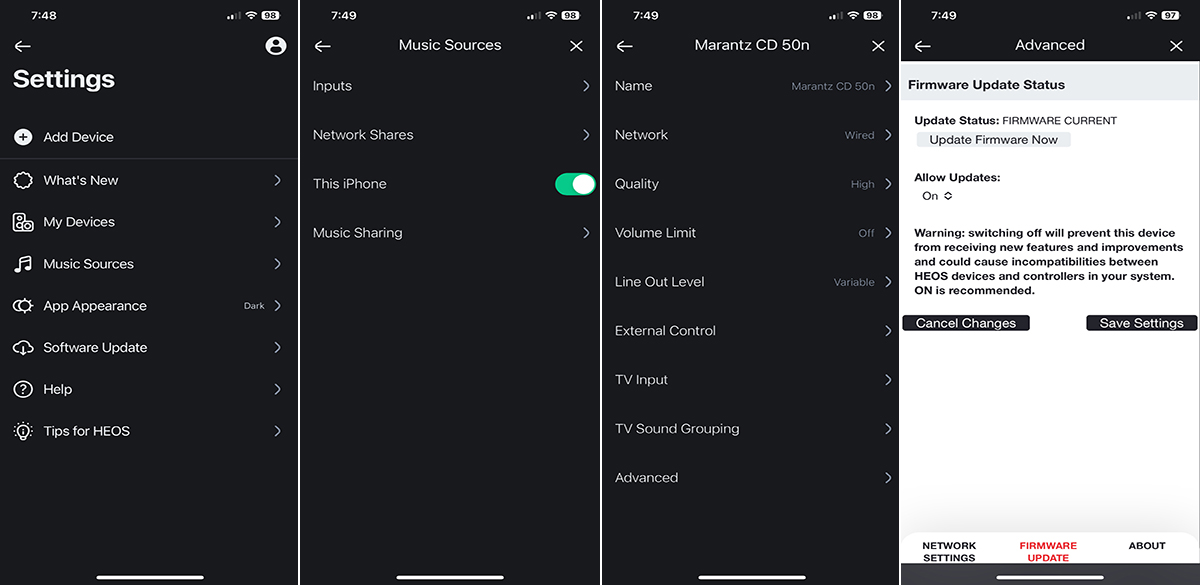
The two reconstruction filters are simply labeled Filter 1 and Filter 2, with the former described in the manual as offering “a short impulse response for both pre-echo and post-echo. Large amount of audio information clearly reproduces deep stereo imaging and the relative position of the sound source,” whereas the latter features “asymmetrical impulse response. The post-echo is slightly longer than the pre-echo. The sound characteristic is more analog-like.”
In other words, Filter 1 is a linear-phase filter and Filter 2 is minimum-phase. I checked out Filter 2 briefly, but preferred Filter 1 ever so slightly, so I left it alone for most of my listening.
Other settings only accessible via the remote that you might consider tweaking are the auto-standby function (which can be dialed in to the minute, or you can select from preset times up to 15 minutes). Via the app, you’d definitely want to enable one function that ought to be on by default: the ability to access music stored on your phone, even if you’re an iPhone user like me. That’s exceedingly rare for multiroom digital ecosystems these days, and should be applauded.
The remote, it must be said, is a nice one—standard Marantz design, mind you, but that doesn’t make it any less nice. It can be used to control both the CD 50n and the Model 50 quite easily and intuitively, and if I had to make one gripe about its design, I wish the carved-out finger notch on the back was a bit higher, perhaps opposite the volume/input controls instead of opposite the d-pad.
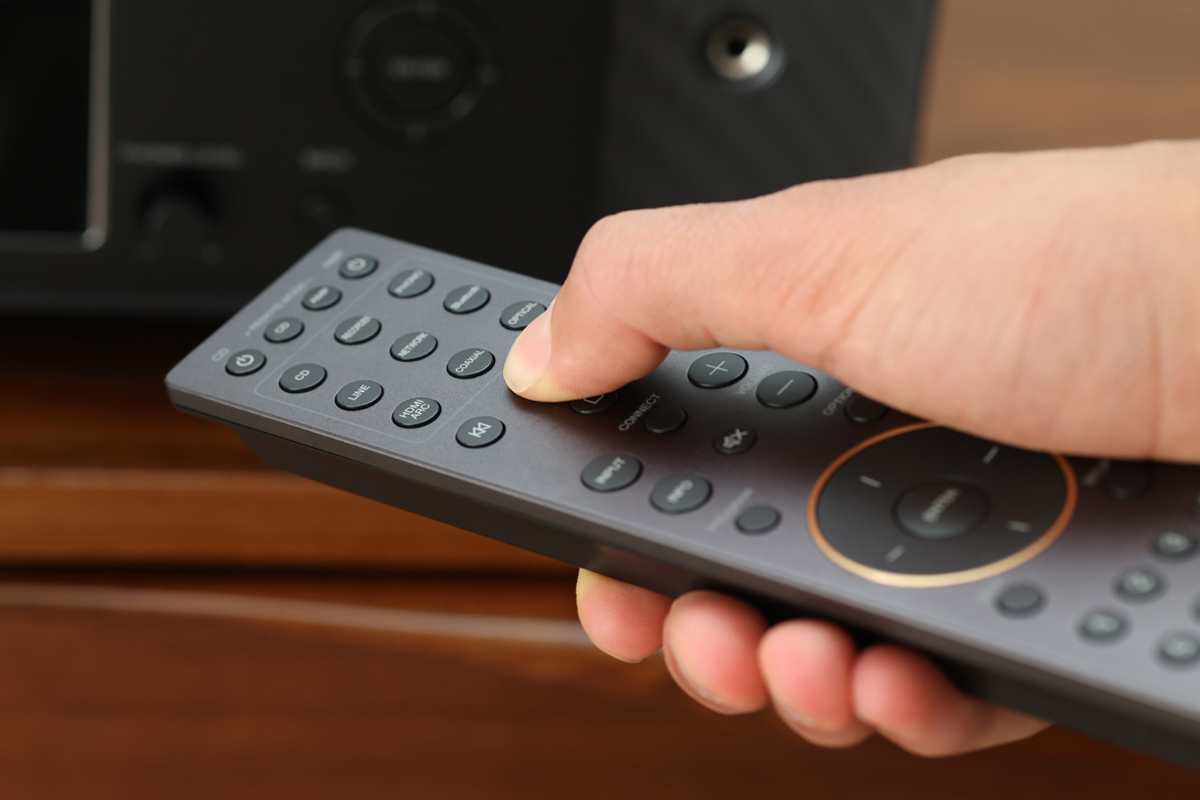
Back to the app, in addition to local files you can also access streaming services, as long as you subscribe to one of the following: Pandora, Amazon Music, Deezer, iHeartRadio, SiriusXM, SoundCloud, or Mood:Mix. The player also supports Spotify Connect and Tidal Connect, so you can cue up music in the apps for those services and then transfer playback to the CD 50n.
As mentioned above, no Qobuz, and no Apple Music either, although both can be streamed via AirPlay 2 or Bluetooth, the latter of which almost nobody who would buy this thing would consider using, since it supports the SBC codec only.
Not that you’d know that from looking at the front panel—or any of Marantz’s online literature. The onscreen display simply lists song title, artist, and source. Then again, the BT connection is two-way, so you can connect your favorite set of wireless cans when the time comes for more private listening. Alternately, the CD 50n has a full adult-sized headphone jack with good output and a separate volume control. Plugging in headphones doesn’t automatically cut the line-level output, though, so if you’re into personal listening, make sure to turn off or mute the amplifier that the CD 50n is connected to.
Listening impressions
It’s been a bit since I had a working CD player in my two-channel system, so it was with some excitement that I reached for my stack of Grateful Dead discs and cued one up as soon as I had the CD 50n running. The album in question ended up being Dave’s Picks Volume 14: Academy of Music, New York, NY • 3/26/72 (Rhino Records R2-548604), a rip-roarin’, non-European 1972 show that features one of my favorite renditions of “Playing in the Band” from the Pigpen era.
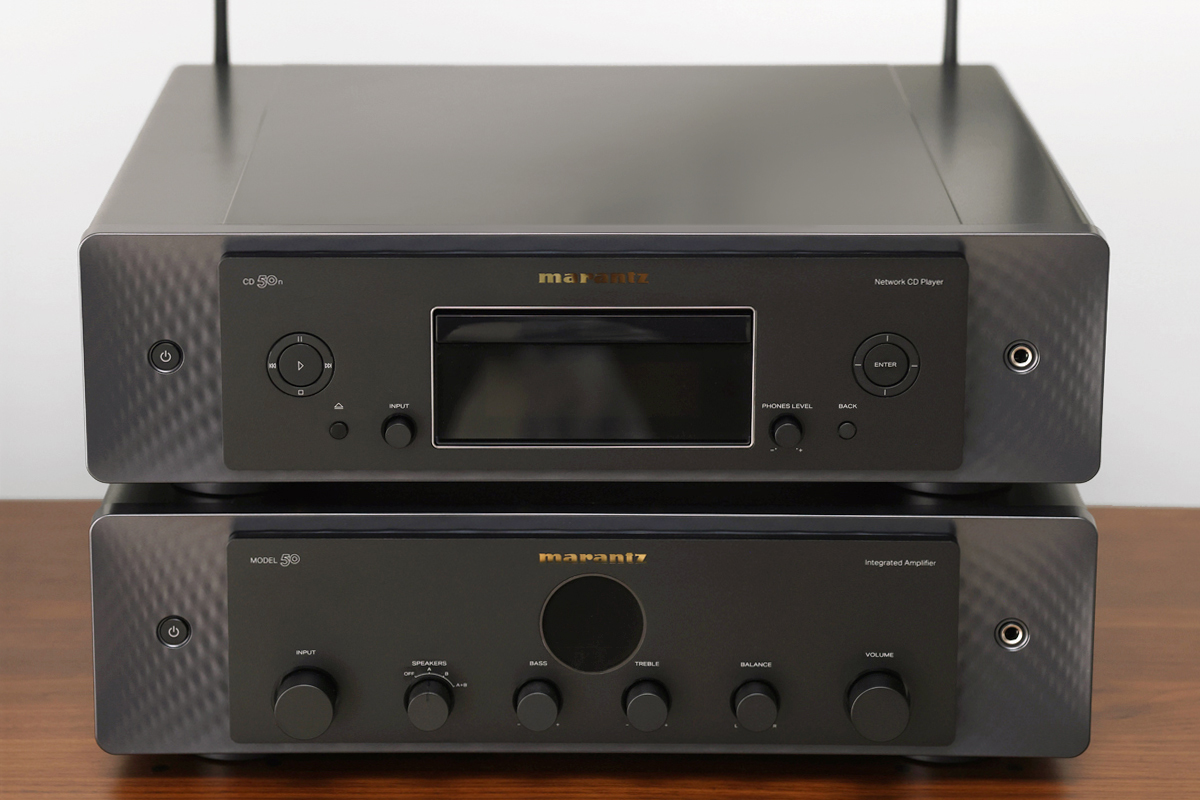
Long story short—when paired with the Model 50 integrated amp, which drove my reference Paradigm Studio 100 towers, the CD 50n delivered everything this recording has to offer: richly nuanced textures, especially the contrast between Billy’s tightly punchy drumming and Pig’s loosey-goosey, whiskey-soaked, booty-shaking washboard scraping. Even little flaws in the recording that make it what it is but that sometimes get lost via some gear—such as the slightly diffuse and wobbly image of Bobby’s vocals, the occasional burp from Phil’s bass cabinet, and the fact that Jerry sounds like he’s standing about two feet behind everyone else—were rendered here without any editorializing. It’s everything you want a digital audio player to be—precise, accurate, neutral, and non-noisy.
Since I also have this album ripped in ALAC to my iTunes library, and since the HEOS app lets you play music from your phone with no issues, I took the opportunity to compare the CD 50n’s streaming and disc-playback performance back-to-back. Sonically, I couldn’t hear any meaningful differences. Frankly, switching between the two reconstruction filters made way more difference, however minor it may have been.
What that tells me is that the CD 50n doesn’t decode HDCD, the physical format in which all Grateful Dead records are released these days. Again, it would be so much easier to tell these sorts of things if Marantz gave any meaningful info about decoding and playback on its LCD screen. At any rate, previous experimentation with streaming disc players that do decode HDCD leads me to expect just the tiniest touch more dynamic punch, especially from the percussion, when the format is properly decoded. But it’s such a minor issue that I wouldn’t be concerned about it, and I think the days of HDCD being supported in hardware are over.
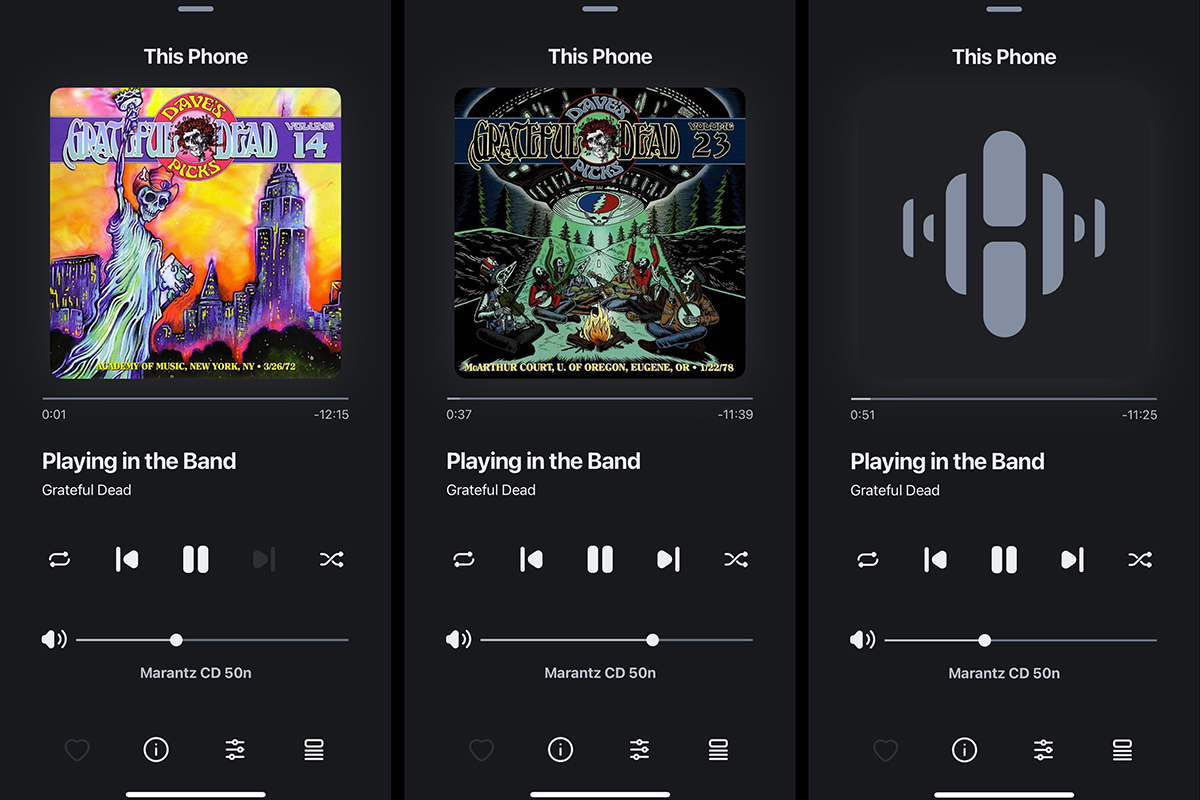
One odd quirk of using HEOS to stream from my local library on my iPhone is that it occasionally got the artwork wrong. When playing Dave’s Picks Volume 14, for example, it sometimes inexplicably displayed the cover artwork for Dave’s Picks Volume 23. I checked the cover art within the Music app and it was fine. I checked the metadata of my rip on my PC, and found no problems.
I killed the HEOS app on my iPhone and restarted it, and the artwork sorted itself out. But on occasion this would happen with other Dave’s Picks rips in my library for reasons that make no sense to me. And sometimes I just wouldn’t get artwork at all. Oh well—little oopsies like that are easy to forgive with a platform that’s just had this big an overhaul, and I’m sure Masimo will sort it out soon enough.
My listening impressions were similar with Joanna Newsom’s Ys (Drag City DC303), specifically the song “Sawdust & Diamonds.” What I’m listening for when I use this cut as test material falls under the audiophile-cliché umbrella known as “attack and decay.” I’m listening for transients—the alveolar plosives when Newsom sings “drop a bell off of the dock . . .,” the attack of each plucked harp string. I’m also listening for things that might get chewed up by a stupidly designed low-pass filter: the natural reverberance of the room and the way notes hang in the air within it. I’m listening for the little details like the natural mouth noises, the tiniest of breaths. I’m listening for the ambience of the room in which the track was recorded. In short, the CD 50n excelled at it all, whether via disc, my ALAC rip via the HEOS interface, or even via AirPlay 2.
Headphone listening
I mentioned above that the CD 50n’s headphone output has its own little volume control (not accessible in the app or on the remote control, oddly), but what I didn’t mention is that buried in the setup menus via the onscreen menu are three selectable gain settings for the headphone amp. With a 32-ohm load, Marantz specifies the output in the high-gain setting as a respectable 200mW. With more sensitive headphones or in-ears, the mid- and low-gain settings reportedly deliver 120mW and 16mW, respectively.
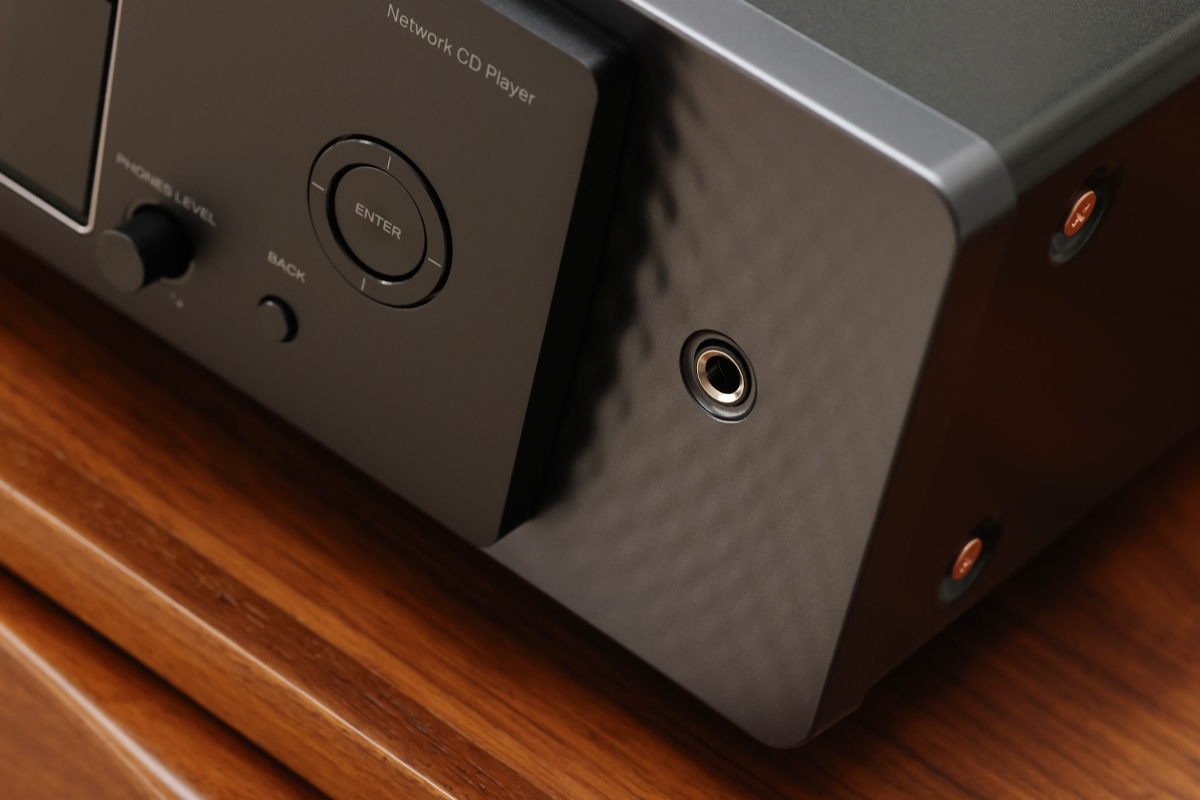
And the gain settings do make a meaningful difference. With my thirsty Audeze LCD-2 open-backs—which a few recent amps I’ve reviewed have struggled to drive—the headphone output of the CD 50n rendered my go-to headphone-audition track, The Allman Brothers Band’s “Blue Sky” (Eat a Peach, 24-bit/96kHz FLAC, Mercury Records / Qobuz, transcoded via AirPlay), unimpeachably. Every detail of the recording was reproduced with clarity and authority. That rhythm punch that I listen for felt every bit as tactile as you could ever hope for through headphones, and the subtleties like the hum and saturation of the guitar amps were hard to miss.
A move to my Ultimate Ears Capitol Records Reference UE Pro in-ear monitors necessitated a switch to the low-gain mode, but once that was sorted out, all of the above remained true. The headphone amp built into this thing would suffice as a standalone product, for sure.
Comparisons
Unless you’re itching to drop an extra $1199 for the Marantz SACD 30n, the new CD 50n doesn’t have a lot of one-to-one competition, so we’re going to have to glance sideways and squint a little to make this comparisons section work. Apologies for that.
If what you’re looking for is a CD player that can also do streaming, I hear good things about the Technics Grand Class SL-G700M2 streaming SACD player–preamp ($3499.95), although I haven’t tested it myself. It has balanced and single-ended outs, which might grab your attention. Based on my experience with the Grand Class SU-GX70 streaming stereo receiver, though, I’m not a huge fan of the Tecnhics app.
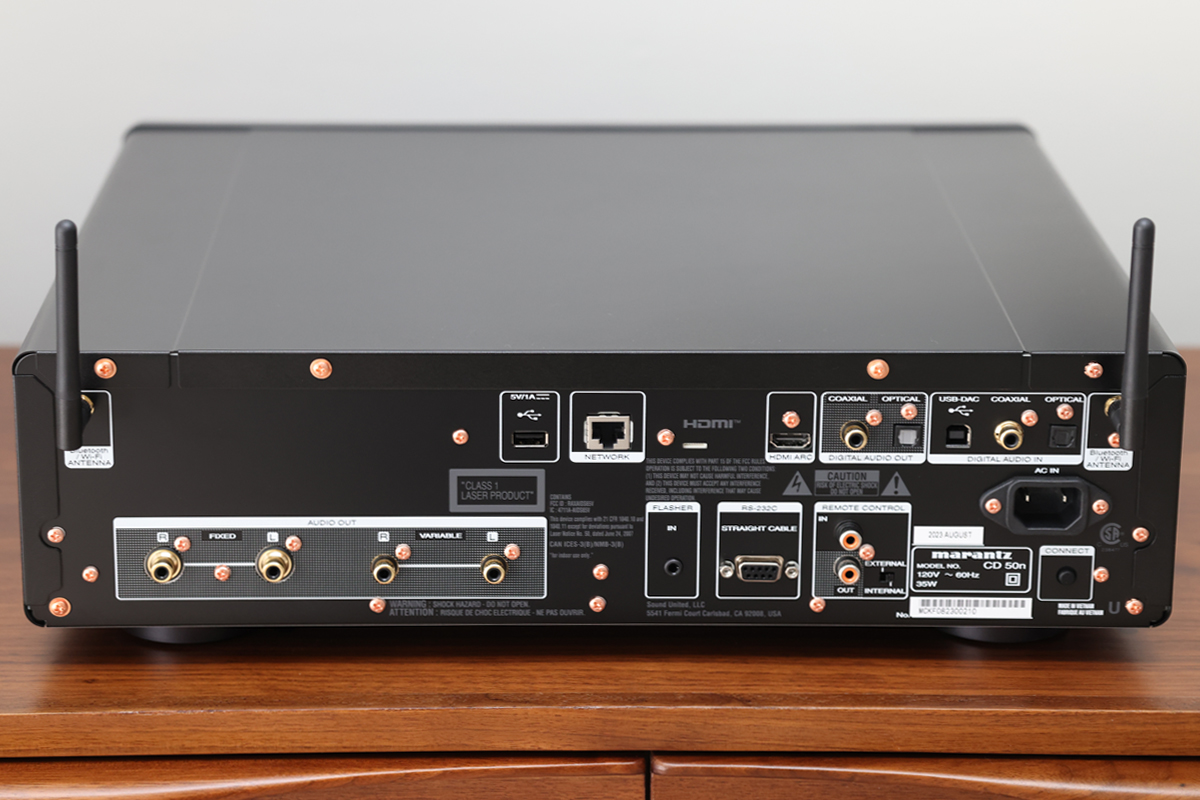
I also hear some nice rumblings about the Primare CD15 Prisma ($2100). Like the Technics, it largely relies on Chromecast or AirPlay 2 for streaming connectivity, so there’s no HEOS-like multiroom centralized app-control experience. It also lacks a USB-B port, if that’s your preferred digital connection.
If, on the other hand, you don’t need a physical CD slinger in your system, you’re probably better off opting for the Marantz Model 40n streaming integrated amplifier ($2499), which is cheaper than this stack and still one of the best values in hi-fi, in my opinion. Compared to a CD 30n–Model 30 combo, that would still leave you with $1101 in your budget for a good dedicated disc-spinner, which would take you a long way indeed.
Conclusion
There’s one aspect of living with the CD 50n (and its companion piece, the Model 50) that doesn’t really come through in much of the above prattle—just how nice it is to walk into my two-channel room every day and look at this gorgeous stack of gear. Seriously, the amount of personality this thing has just sitting there in standby mode is hard to deny.
I also like the direction in which HEOS is heading, despite the handful of small bugs. The persistent Now Playing widget is a big improvement, the universal search is, in my opinion, necessary these days, and the overall look is fab.
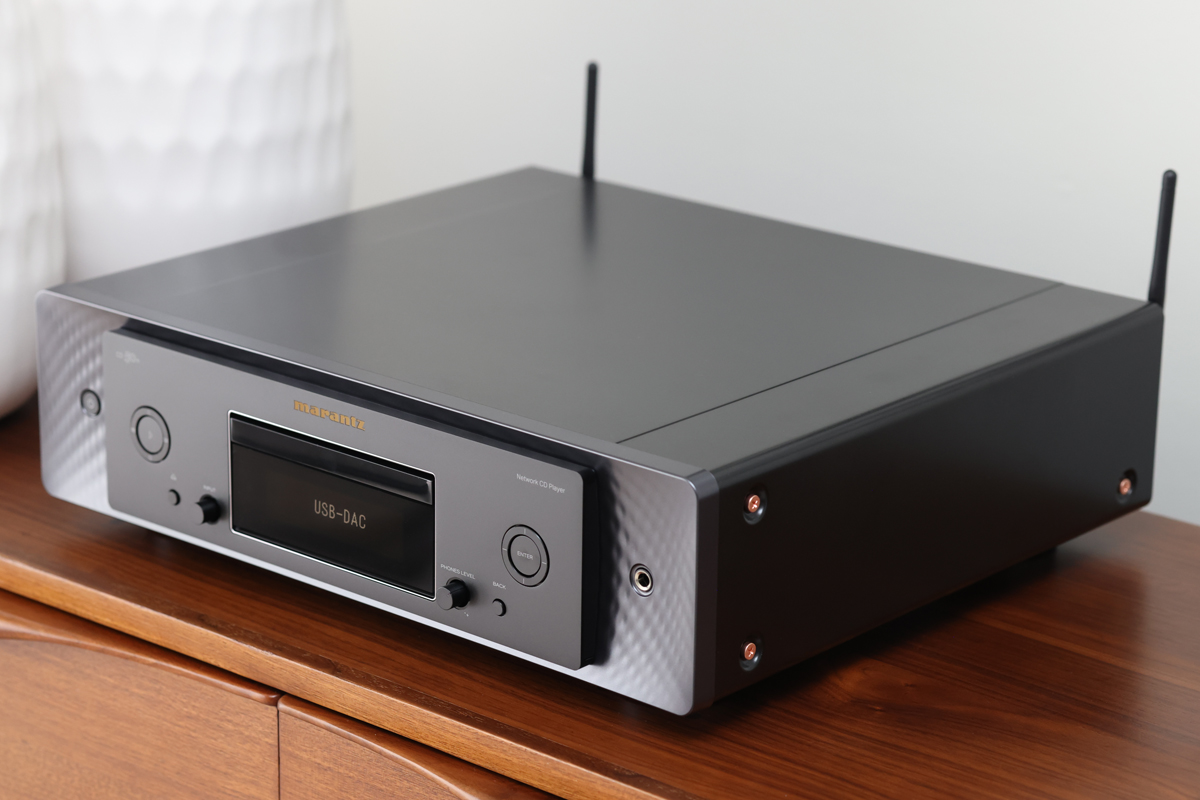
It’s a shame that Qobuz isn’t supported. I guess we iOS users should feel fortunate that there’s AirPlay functionality to cover all the streaming services not natively included in the HEOS experience.
I do wish it had HDCD decoding at this price, but given that literally nothing else new to market has that feature, it’s hard to complain. Long story short, if you want physical CD playback along with HEOS streaming, Bluetooth connectivity, AirPlay 2, et cetera, and you want your gear stack to look this saucy, the CD 50n and Model 50 combo is super-compelling.
. . . Dennis Burger
Note: for the full suite of measurements from the SoundStage! Audio-Electronics Lab, click this link.
Associated Equipment
- Integrated amplifier: Marantz Model 50.
- Speakers: Paradigm Studio 100 v.5.
- Speaker-level connections: ELAC Sensible Speaker Cables.
- Line-level connections: Straight Wire Encore II analog interconnects.
- Sources: Maingear Vybe PC; iPhone 12 Pro Max.
- Power protection: SurgeX XR115 Surge Eliminator/Power Conditioner.
Marantz CD 50n Streaming CD Player
Price: $1800.
Warranty: Five years, parts and labor.
Masimo Consumer
5541 Fermi Ct.
Carlsbad, CA 92008
Phone: (844) 298-5032
Website: marantz.com





